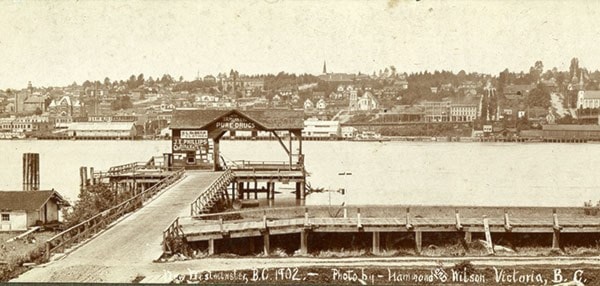PART TWO IN A SERIES: Between the two points where Fraser Surrey Docks and Port Kells are located, plenty of history has happened along the Fraser –and it helped shape Surrey into the city it is today.
Surrey’s entire shoreline along the mighty Fraser is only 22 kilometres. It’s a short stretch, really, on a river that flows for 1,375.
Still, while short on frontage, Surrey’s relationship with the Fraser River is long on interesting nautical history.
At the city’s furthermost boundary downstream is the imposing Fraser Surrey Docks.
 You can’t miss it. It handles roughly 400 deep-sea vessels each year. In 2012, Fraser Surrey Docks celebrated its 50th anniversary.
You can’t miss it. It handles roughly 400 deep-sea vessels each year. In 2012, Fraser Surrey Docks celebrated its 50th anniversary.
(Fraser Surrey docks, the largest multipurpose terminal on North America’s west coast, has been in operation 55 years. File photo)
At Surrey’s furthermost boundary upstream is Port Kells, where in 1886 two unrelated Irish settlers named Henry Kells bought land and divided it into city lots, hoping to see a grand freshwater port established there though fate was not with them.
In between these two points, separated by 22 kilometres, plenty has happened.
Let’s begin with the Kwantlen Empire.
As late as the beginning of the 19th century a small Kwantlen village called Kikait was situated where Brownsville is today, just a short stroll downstream from the Pattullo Bridge which was opened by Liberal Premier Thomas Dufferin Pattullo on Nov. 15, 1937 and cost $4 million to build.
Local historians John Pearson and J.M. Reitz recorded the adventures of Punnis, a Kikait chief who launched an unsuccessful attack on the Hudson’s Bay Company schooner the Cadboro in 1827 as it made its way up the Fraser.
Within several decades white settlers overwhelmed the little village and most of the Kwantlen migrated to Fort Langley. Its last chief met his maker in 1908.
Brownsville is across the Fraser from New Westminster. It’s named after Ebenezer Brown, a New Westminster liquor merchant who pre-empted land near Kikait in 1864, and built a hotel. In later years, Brown’s Landing marked the junction of Scott Road, Kennedy Trail and the Old Yale wagon road, which connected the Royal City with B.C.’s Interior.
Surrey farmers needed to find a better way to transport their produce to market in New Westminster than by rowing skiffs across the Fraser, and so a ferry landing was built in Brownsville in 1882.
 Surrey Reeve John Armstrong set about establishing ferry service in 1883 and the Kate de Knivett, or K de K, a steam-powered ferry built by Captain Angus Grant and named after Grant’s niece, made its maiden voyage across the Fraser on March 17, 1884.
Surrey Reeve John Armstrong set about establishing ferry service in 1883 and the Kate de Knivett, or K de K, a steam-powered ferry built by Captain Angus Grant and named after Grant’s niece, made its maiden voyage across the Fraser on March 17, 1884.
(The ‘K de K’ ferry, built by Captain Angus Grant. Photo: Surrey Archives)
The ferry cost $2,000 to build. Foot passengers paid five cents to cross the river and passengers with a horse or wagon, 25 cents. Its skipper was Grant’s son, Williiam Philpot Grant.
The K de K was replaced by another steam-powered ferry, the Surrey, in 1889 until it too fell victim to progress with the opening of the New Westminster railway bridge on July 23, 1904.
 The bridge’s lower deck was for trains and the upper deck was for wagons and cars, and it remained a toll bridge until the Great War.
The bridge’s lower deck was for trains and the upper deck was for wagons and cars, and it remained a toll bridge until the Great War.
(The steamer ‘Surrey’ ferried people and supplies between New Westminster and Brownsville from 1889 until 1904. Photo: Surrey Archives)
Stern-wheel steamers that ran up, down and across Surrey’s stretch of the Fraser were the Courser, skippered by Captain George Cooper, the Telephone, a series of snag boats steaming under the name Samson, the S.S. Paystreak, the Gladys, and the Bon Accord. The Samson V was a snag-puller that worked these waters from 1937 to 1980.
The last original Fraser River paddle wheeler remaining, it was converted into a maritime museum and can be visited at New Westminster Quay.
Upstream from the Fraser Surrey Docks and downstream from Port Kells was Bon Accord, a minor steamboat stop on Surrey Bend that later came to be known as Port Mann.
The Ottawa Citizen newspaper on Feb. 8, 1911, heralded the establishment of the Port Mann townsite, which was to feature a steel mill, grain elevator and flour mill, a large dock and yards for shipbuilding. But as in the case of Port Kells, this dream didn’t pan out either.
Another ship of note that worked the Fraser River was the Surrey Guardian, Surrey’s first fire boat.
Bought in 1968, it had three skippers, John Menunzio, Rudy Brieter and Bob McNabb, before the fire department sold it four years later to raise money to buy a ladder truck.
The Fraser River Discovery Centre, located in New Westminster, aims to unveil a special exhibit this coming September to celebrate this world-class “Working River.” According to the FRDC, almost every car coming into Canada from Asia is shipped in through the Fraser River. In 1998, the Fraser was designated a Canadian Heritage River.
Click here to read part one in this series.
tom.zytaruk@thenownewspaper.com
